60-Second Summary
You're handling 3 critical projects at once, but your in-house team feels overwhelmed and lacks the technical expertise to meet the project timelines. At the same time, you’re constantly juggling between cost, control, and speed cycle.
The challenge? Finding the trusted external vendor without losing control or breaking your budget.
You've two options: outsourcing and staff augmentation. While your competitors are rolling out digital products faster, you need to make the right choice quickly because the wrong one can inflate your budget and slow your growth.
To give you a quick answer, if your goal is to get more output, such as delivering complete projects without handing them control over the development process, then choose outsourcing.
But if you want your internal team to be in sync with the external vendor and achieve predictable progress with greater control over day-to-day execution, then staff augmentation should be your go-to choice.
In this guide, we'll break down the differences between staff augmentation and outsourcing so you can confidently choose the model that aligns with your business goals.
Staff augmentation involves businesses hiring temporary staff to fill specific expertise and skill gaps within the company. The outsourced development team (developers, testers, designers) becomes part of your existing team, expanding your capabilities.
For example, you're looking to add 2-3 skilled DevOps engineers to augment your team's capabilities and fulfil specific requirements.
This approach solves a common business challenge: Let's say you have a lot of projects on your plate, your existing team is already occupied, and you urgently need more people for one of them.
But doing full-time hiring means endless interviews, salaries, and long, month-long processes. That becomes expensive and time-consuming.
Best part? You can scale IT resources up or down as needed for your project, and your team still maintains oversight.
This model has proven effective across industries.
EdMc Callister, Senior Vice President and CIO at University of Pittsburgh Medical Center, says
"Staff Augmentation plays a greater role in healthcare IT. Telemedicine is one such example where we went from 0 to 100 overnight.
We had achieved more in just one day than we had in 6 months. Yes, our team was good enough, but staff augmentation made things easy and helped us achieve."
Not only does this make you more efficient, but it also saves 30-50% on development costs, which can be reinvested in your business's growth.
”Under project outsourcing, a business partners with an external firm to complete projects for a certain period. Sometimes only specific aspects are outsourced, while other times the full product development cycle is handed off.
Though they may seem similar, outsourcing and staff augmentation are fundamentally different. With staff augmentation, your technology vendor fills skill gaps while you retain control over the development process.
But with outsourcing, you work with a dedicated development team that operates independently; they decide everything from planning through execution.
For example, if you outsource app development to an offshore outsourcing partner, the vendor takes completes responsibility for design, development, QA, and delivery timelines. Project requirements are fixed beforehand, but the vendor manages the delivery.
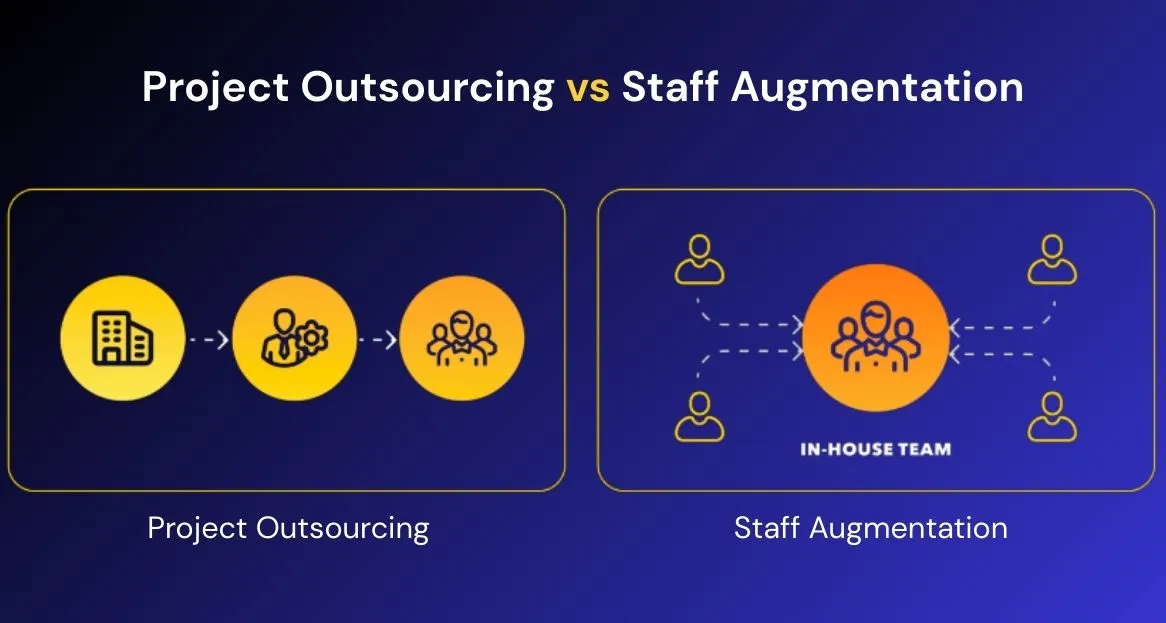
Here’s what makes staff Augmentation different from project outsourcing
Aspect | Outsourcing | Staff Augmentation |
Definition | The client hands over the complete project or a specific module to an external vendor. | Client borrows skilled professionals from the vendor to work within their internal team. |
Ownership of Delivery | Vendor owns end-to-end delivery (requirements → development → testing → deployment) | Client owns delivery; augmented staff only support execution. |
Management & Monitoring | Minimal client involvement; vendor manages the entire cycle. | High client involvement; resources are managed daily by the client. |
Control | Vendor controls processes, timelines, and execution approach. | Client controls priorities, workflows, and task assignments. |
Flexibility | Limited flexibility once scope and contract are locked (especially in fixed-cost models). | Highly flexible; clients can scale and descale resources as per their needs. |
Ideal Use Case | Projects with clear, stable requirements and defined outcomes. | Projects where requirements are evolving or not fully defined. |
Risk Handling | Vendor is responsible for project risks and delivery challenges. | Client manages risks since they control the team and direction. |
Cost Structure | Usually fixed-cost or milestone-based; scaling is difficult without renegotiation. | Time & material (monthly billing per resource); easy to adjust team size anytime. |
Client Effort | Low effort; no need for daily supervision. | High effort; requires active involvement and oversight. |
Time to Start | More time needed for planning, scoping, and contracting. | Quick onboarding; teams can be expanded faster |
Let’s explain these differences in detail -
In case of Staff Augmentation, though your in-house team is hiring temporary workers, the technology partner will still follow your project processes. The client will have direct control over the development process and the augmented staff.
But when you outsource the design and development work to an outside technology vendor, who will build their team, manage the projects, and give results, your involvement is minimal. This can have significant consequences as you don’t have visibility into their daily workflows.
Staff Augmentation | Project Outsourcing |
The client owns delivery, but the vendor just supports the client in project execution. | The vendor owns the delivery end-to-end, from requirements through development, testing, and deployment. |
Staff augmentation is a more flexible approach than project outsourcing, as you (the client) can scale or descale resources as per project requirements.
While the project-based outsourcing model follows a more rigid approach, with the project scope defined beforehand, especially for fixed- or milestone-based projects.
For example, for MVP or website design, staff augmentation outsourcing is not a feasible option for projects that require continuous changes.
Pro tip – Staff augmentation works best for changing or uncertain needs.
Outsourcing is a viable option for projects with fixed requirements.
IT staff augmentation services are more cost-effective because costs are flexible and billed under a time-and-materials engagement model. It typically costs between $40-$100/hour and $100-$200/hour onshore.
So, this saves your recruitment expenses that would otherwise be spent on hiring permanent full-time resources, and there are no additional expenses for investing in office space or purchasing equipment.
But project outsourcing is a lower-tier approach, as you define the project scope and hand it off to a third party. It can cost as little as $20K or as much as $100K+.
But if there are sudden changes in project requirements or feature updates, it might increase project costs in the long run.
In staff augmentation, you’ll have better control over your business operations. It's like hiring software developers who will follow the organization's structure, report to your manager, and follow the company’s processes.
The augmented staff will not disrupt your internal workflows, as you’ve control over how you handle sprints, the review cycle, and communication.
Outsourcing projects to a third-party vendor means you lose daily oversight and control of the project, and if there are any changes along the way, things can become a little complicated.
Here’s what outsourcing looks like
Hand off the project > Pay for the outcome > Let experts own it with their tools and processes
Staff augmentation reduces onboarding time for tech professionals, allowing them to start working on the project quickly. A little time can be invested to help them understand your processes and systems.
However, the onboarding time required to set up a dedicated development team is longer, as they need to understand project scoping, define deliverables, and the contract.
Here are a few advantages of choosing a staff augmentation model for your business -
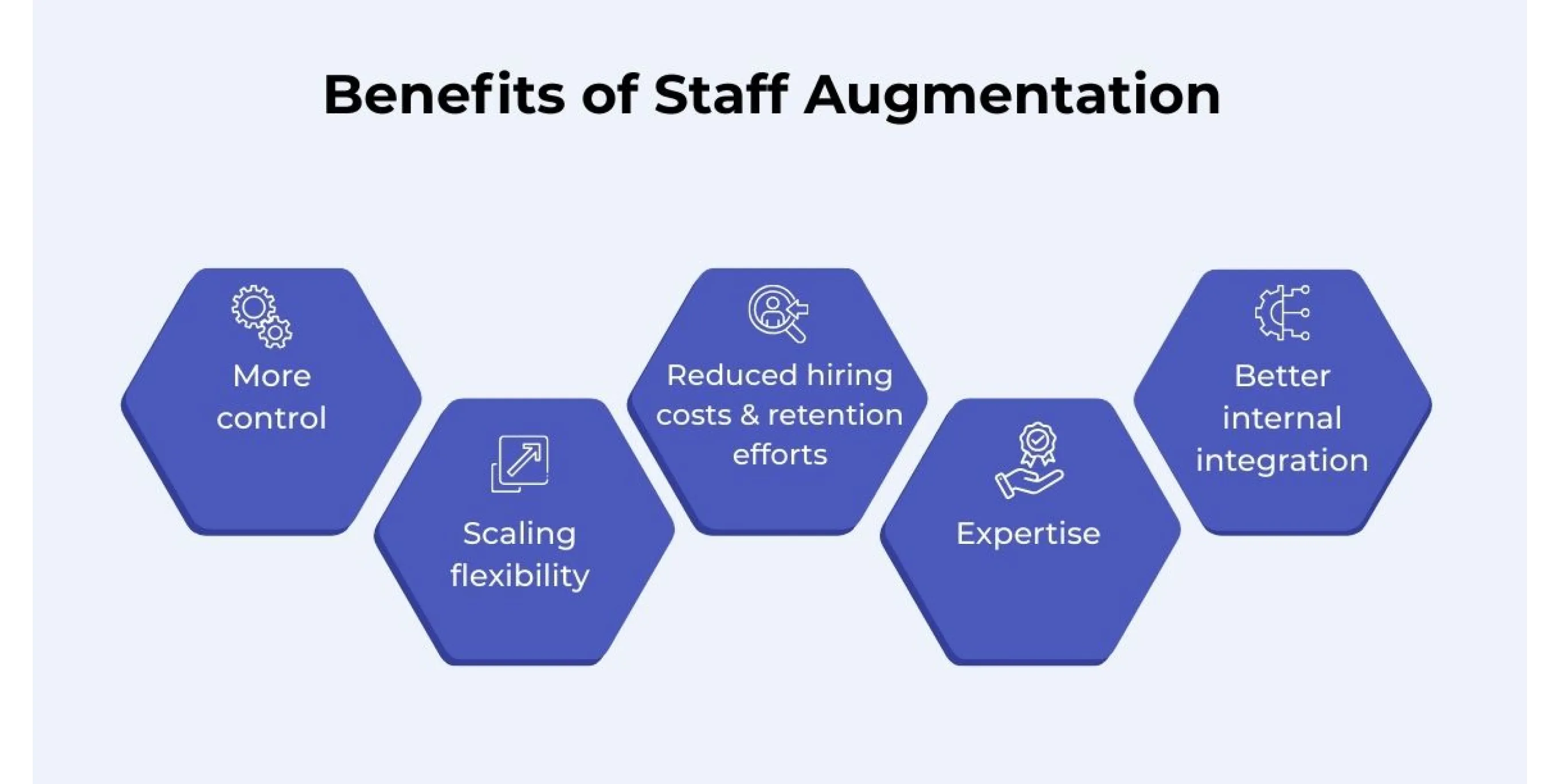
With the physical presence of hired specialists on-premises, businesses have direct oversight over the working of a specialist and the progress of the project. Furthermore, companies have the liberty of involving the augmented staff in multiple projects, according to the business requirements.
Through the staff augmentation model, businesses enjoy the flexibility of scaling up or scaling down their staff/teams. In case a project expands or contracts over time, or timelines change, a business doesn’t need to worry about hiring or firing additional employees. You simply pick the most suitable outsourced people for your project and scale according to business needs.
Since IT staff augmentation providers handle administrative duties, a business does not need to worry about recruiting, hiring, retaining, or incurring the costs of a full-time employee.
This eliminates the lengthy recruitment process while giving you the flexibility to scale the team as per your project requirements.
The staff augmentation model works on a pay-as-you-go basis—you're paying for what you need when you need it. This proves to be more cost-effective than the project outsourcing model, as training costs and benefit costs drop to $0 since there's no hiring of permanent staff.
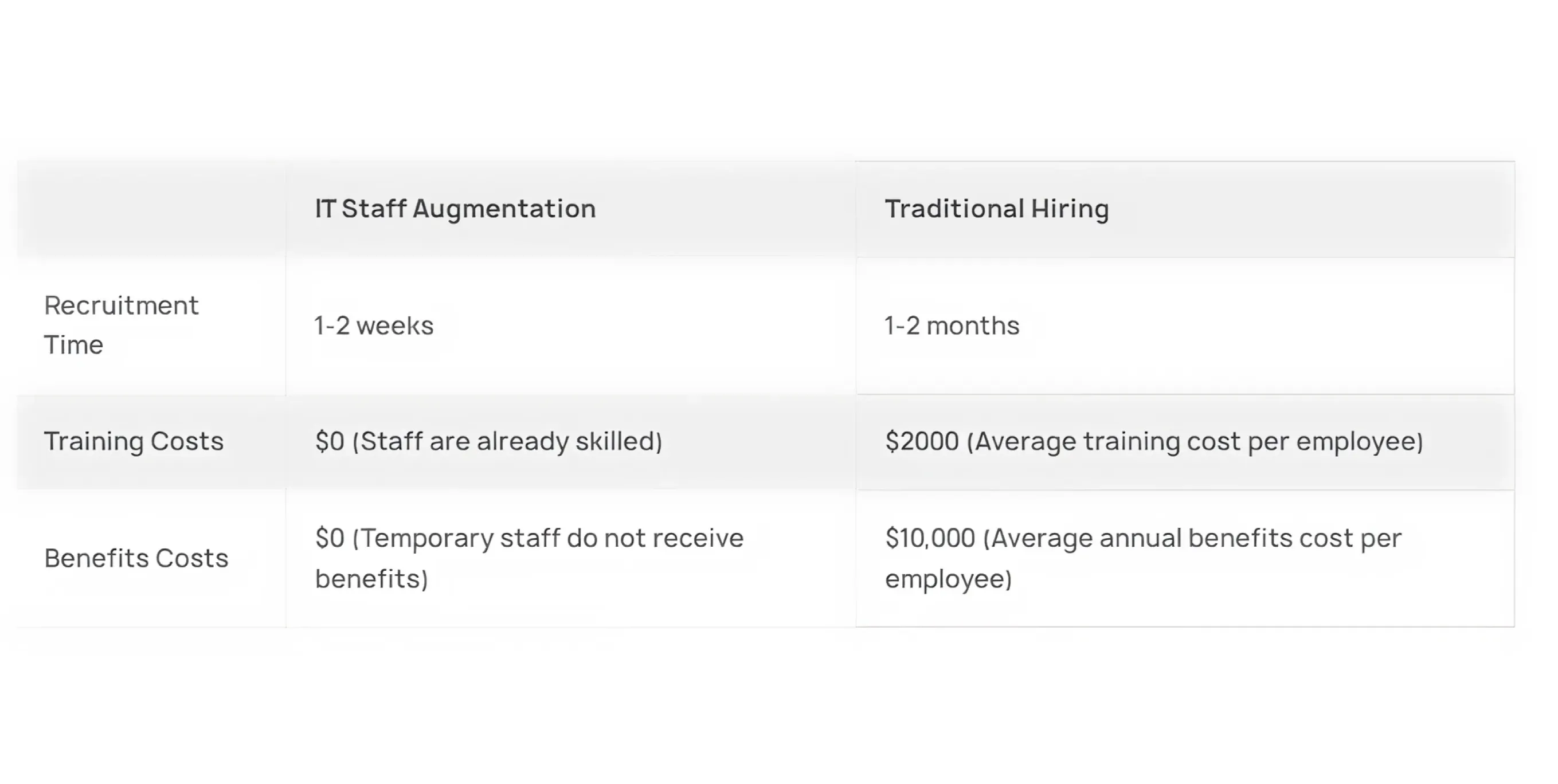
Andy Heyes, managing director at UK&I and Central Europe at Global technology recruiter, Harvey Nash, says
The most obvious benefit of IT staff augmentation is access to talent and skills your in-house team doesn’t have.
”And this is also true: with rising skill shortages of IT professionals, hiring itself has become a headache for many organizations, so staff augmentation can be a blessing, as you can handpick the best industry talent for your business.
The staff augmentation model enables the smooth integration of external hires into an internal team for a project, as opposed to working with a third-party vendor team. In the latter case, there might arise some compatibility issues rooted in cultural and technological differences between the parties.
Here are a few limitations of Staff Augmentation -
Sometimes under the staff augmentation model, the company needs to make necessary infrastructure and managerial changes/additions. Businesses need to hire or reallocate project managers to manage the temporary hires and even provide additional office space according to the size of the augmented staff.
Although you get the most skilled and proficient hires, some resources still need to be devoted to training, as well as educating them about your company culture, operations, and work ethics. This might sometimes slow productivity down, in the initial period, until the outsourced staff gets a hang of your internal business workflows and protocols.
Through staff augmentation service, businesses just get the required resources for a third-vendor company. Therefore, the complete development process, quality control, and hitting the deadlines, are to be looked after by businesses opting for augmented staff services.
Once you’ve brought in resources for your project, there's a high chance of communication barriers, time zone and cultural differences.
But it also depends on whether the staff augmentation company you choose to work with fosters a culture of regular team meetings, have clear communication channels, and ensures that your in-house and augmented teams are in close sync with each other.
The downside of working with a staff augmentation partner is that there is a risk of data breaches that expose the client’s data, information, and trade secrets.
A study from IBM states that the global average cost of a data breach range around $4.4 million.
Note: If you’re augmenting a software team, you need to ensure that your on-demand tech talent follows the security architecture practices and ensures that the client’s data is end-to-end encrypted.
Here are a few benefits of Project Outsourcing -
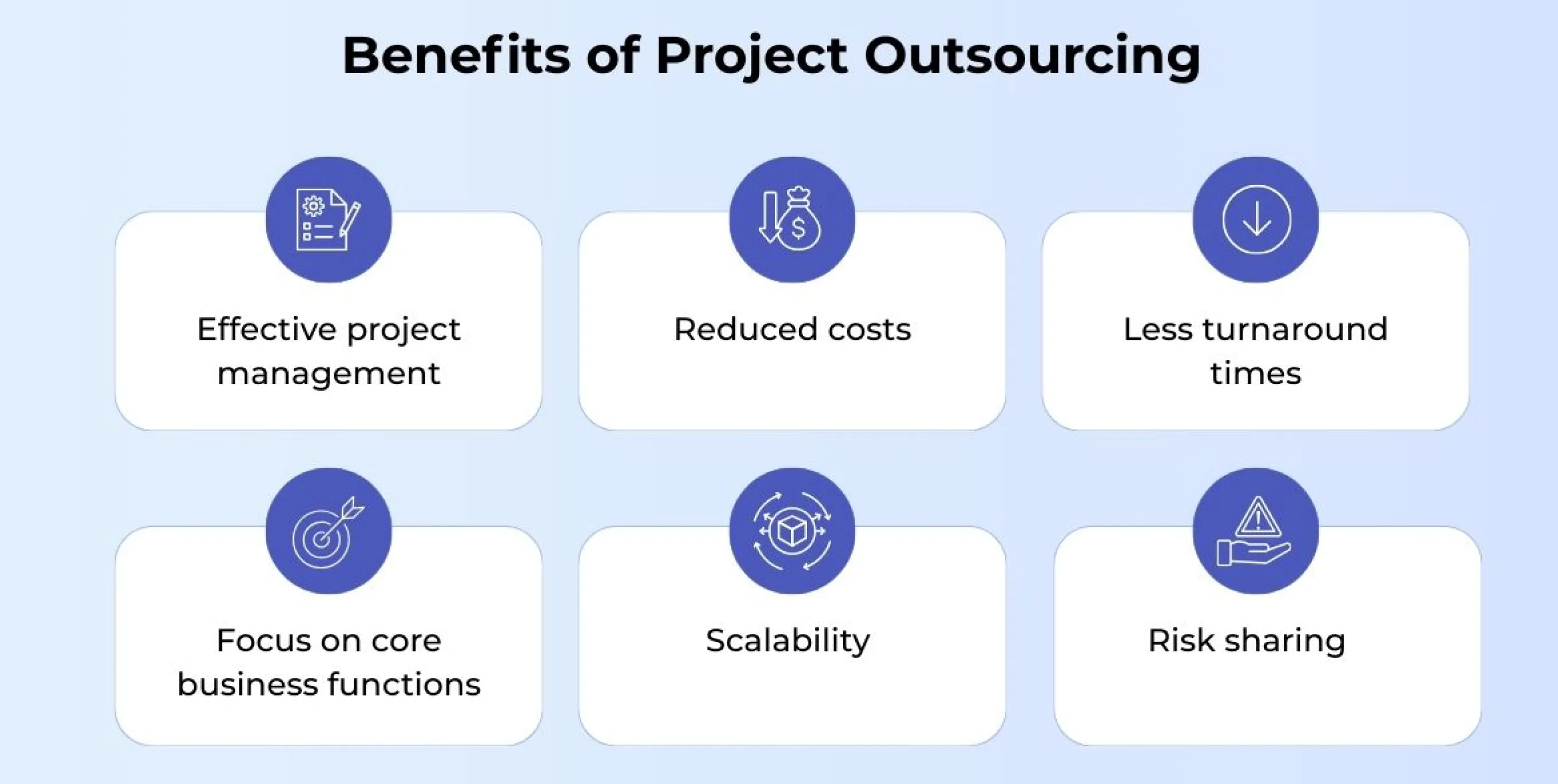
In the project outsourcing model, the entire project is managed by experienced, proficient industry outsourcing service providers. Furthermore, the training required for an outsourcing company to effectively complete your project would most likely be little or none at all.
CIO magazine research stated that ‘CIOs find data science and analytics positions most challenging IT jobs to fill’.
The outsourced project is carried out more effectively as outsourcing companies may leverage their internal economies of scale within their key competencies for a project, giving optimal results.
As per the project outsourcing model, the responsibility of putting together, training, and handling a remote team falls on the vendor. Furthermore, delivery of the final product and meeting the quality standards, are also looked after by the vendor. Therefore, there is no additional management overhead for additional employees with project outsourcing.
In fact, in a survey by Statistics Brain Institute, 44% of American companies that participated said reducing expenses was the key reason for choosing the project outsourcing model.
Under project outsourcing, the velocity of teams collectively is comparatively higher, and therefore, project turnaround time is relatively less. While deadlines are often more flexible and negotiable with in-house/internal teams, an outsourcing company’s success is decided by its timely deliveries.
When a business outsources the product development cycle, they have a window to focus on more crucial, core aspects of the business. Project managers have the room to free up time for in-house employees by outsourcing some development tasks.
By distributing the workload of in-house teams, the utilization of onsite employees becomes more flexible. This way they can be redeployed to work on high-priority projects or projects that are focused on or around the company’s area of expertise.
If a project grows over time or if additional resources are required, it’s easy to scale using the project outsourcing model.
Usually, under the project outsourcing model, any project delays, failures, or liabilities that may arise are the project outsourcer company’s risk.
Here are few limitations of Project Outsourcing -

Since the control of the project lies with the outsourced party, businesses lose direct managerial control over the project. Outsourcing IT projects means leaving the project goals execution, workflows, and delivery deadlines, all up to the outsourcing company. In case of communication gaps, this would turn the whole project and experience around.
It can be more difficult to integrate outsourced projects with internal systems. This is because it requires the business to align with the outsourced IT team.
Because you give up direct oversight with this model, you may run into some quality issues with the final product, which can harm productivity, as well as general team morale as employees, managers, and outsourcing vendors try to figure out who is responsible for these issues. Coding errors that fall short of your firm’s rigorous development standards, undisclosed technical debt, or other technical problems originating from an outsourced development team can be time-consuming and difficult to resolve.
Companies often experience a hard time looking for the right and most suitable outsourcing companies. It is important to invest time in finding the same and be in constant touch or engaged all along the development process to get optimal results.
Furthermore, all aspects and components of the outsourced project need to be finalized during the planning stage, and legalities and documentation must be done and dusted, all before the project kicks off.
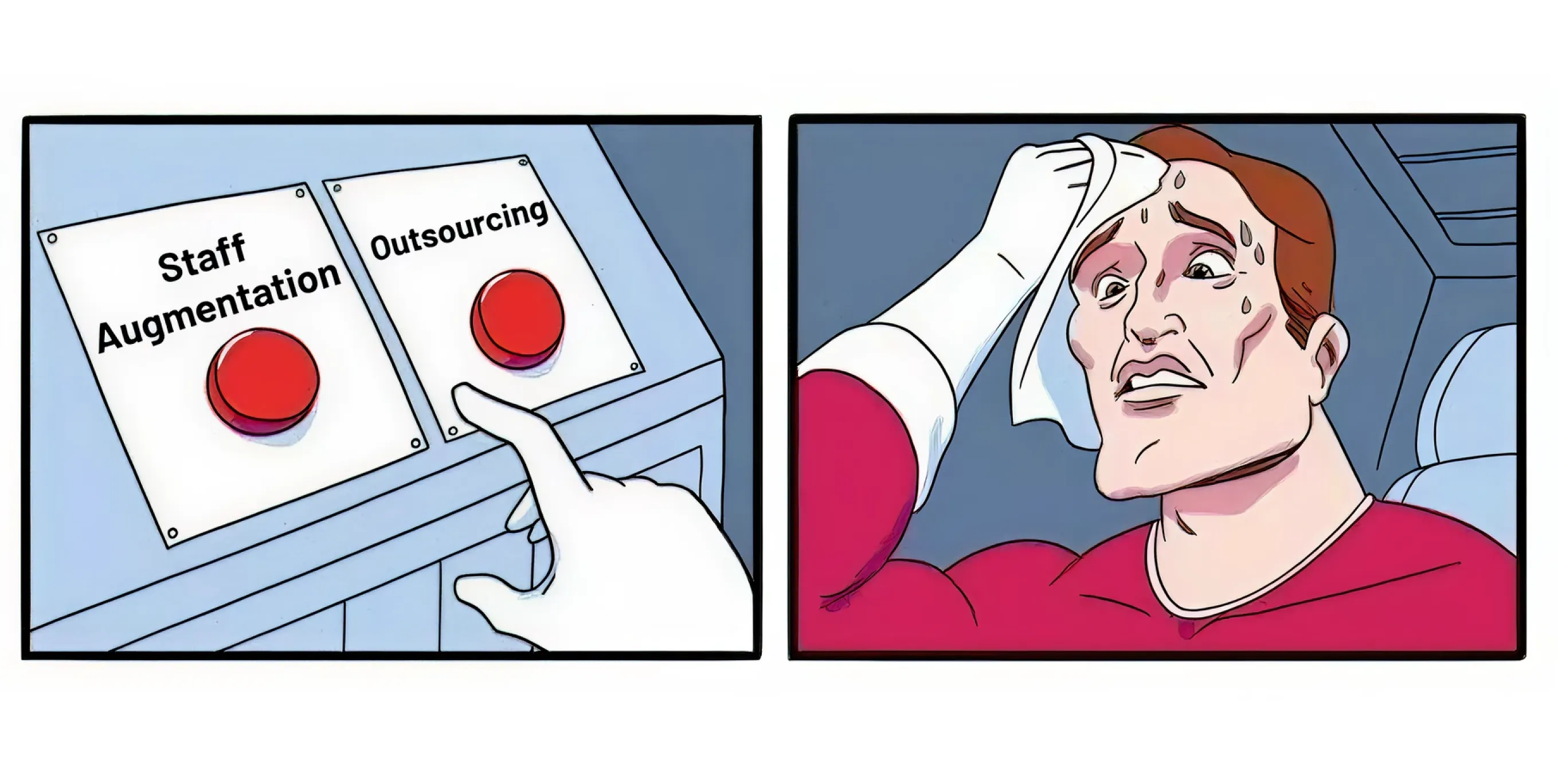
Though we’ve covered the advantages and disadvantages of Staff augmentation and Project-based outsourcing, here’s the quick cheat sheet for you to help you pick the right outsourcing model for your project needs -
Parameters | Staff Augmentation | Project Outsourcing |
Is your project short-term, and do you have specific goals defined? (Yes) | ❌ | ✔ |
Is your project long-term and complex (Yes) | ✔ | ❌ |
Do you want to have tight control over your project? (Yes) | ✔ | ❌ |
Are you comfortable with an external team managing the project? (Yes) | ❌ | ✔ |
Is cost a top priority for you? (Yes) | ❌ | ✔ |
Does your team need any skills that are temporarily lacking? (Yes) | ✔ | ✔ |
Is your team at capacity and unable to take more work (Yes) | ✔ | ❌ |
To not select the wrong outsourcing model, we’ve covered a quick decision matrix to help you make the right choice -
Yes, we know that choosing between staff augmentation and outsourcing has never been easy. Of course, there’s never a one-size-fits-all approach because there are a lot of factors that affect which approach is feasible, such as -
No matter whether you’re looking to hire software developers for a project or a full-stack development team, we've got you covered.
Recently, we served a client named “CarWale”, an automotive player that provides a platform for users to buy and sell used cars. The client needed help in launching an app. They had a strong business and functional team but needed help finding technical talent.
Technical discussions were held, and 28 resources were deployed.
Result – 2x cost savings in hiring and training. Plus, they were able to market their products faster.
”Q1. What is included and excluded in each business model (Staff Augmentation vs Outsourcing)?
Here’s what comes and doesn’t come under the scope of staff augmentation -
What’s included in Staff Augmentation | What’s excluded in Staff Augmentation |
Task execution as per client requirement | Business analysis and requirement clarification |
Code development | Project management |
Bug fixing | Delivery ownership |
Daily or weekly reporting | Testing beyond agreed scope |
What’s included in Fixed Cost/Time and Material | What’s excluded in Fixed Cost/Time and Material |
Business analysis & requirement understanding | Out-of-scope feature additions |
Solution architecture | Third-party licensing costs |
Development & integration | Major scope changes without change requests |
QA (functional, non-functional, API, DB) | Infrastructure costs (unless specified) |
Staffing is the on-going process of finding, choosing, evaluating and developing a working relationship with existing or future employees. Whereas project outsourcing is hiring a third-party vendor for end-to-end product development.
Staff augmentation is hiring specialists or teams from third-party vendor to work on a project onsite. Project-based consulting on the other hand means to consulting a third-party vendor for operational, strategic, or technical understanding of a project.
While staff augmentation means to hire specialists or a team from an outsourcing company to carry out projects on premises, with internal teams, sub-contracting means to assign, or outsource, part of any task under a contract to any other party known as a subcontractor.
Through staff augmentation, you can quickly scale your team by bringing in external developers who will work alongside your internal team. You don’t need to worry about recruitment, payroll, and compliance.
Here are a few benefits of how staff augmentation is helpful for your business -
The different types of projects outsourcing available are professional outsourcing, IT outsourcing, manufacturing outsourcing, project outsourcing, process outsourcing, and operational outsourcing.
The best way to find a good project outsourcing company is to look for options on professional networking sites like LinkedIN, or freelance sites or hire a company through referrals.
The cost of a staff augmentation project can range from $55 to $99/hour. However, the price can scale up or down depending on factors such as the required skill set, the project, and the development team's location.
If you compare the cost of hiring full-time employees, then it’s more cost-effective as you’re paying for the resources you need.
Outsourcing is cheaper than Staff Augmentation because -
But staff augmentation typically costs more than Project Outsourcing because you’re paying hourly rates for developers.